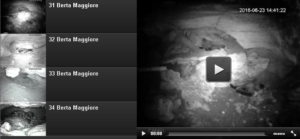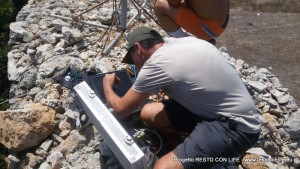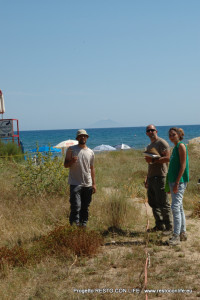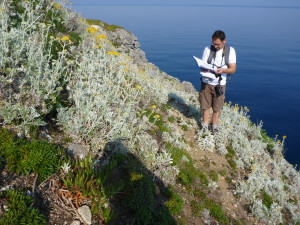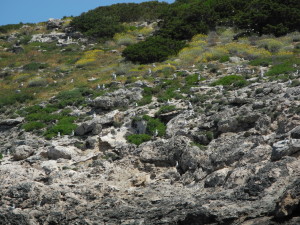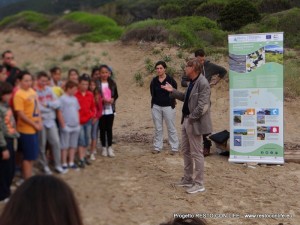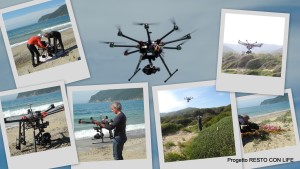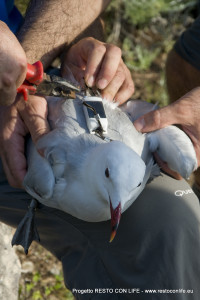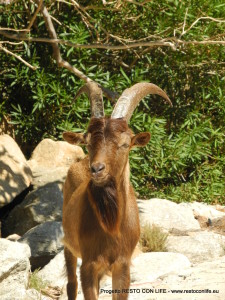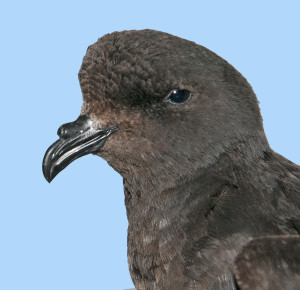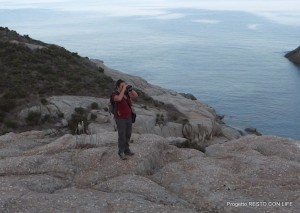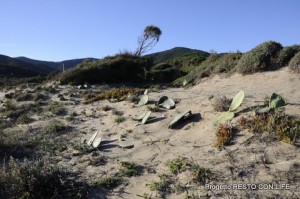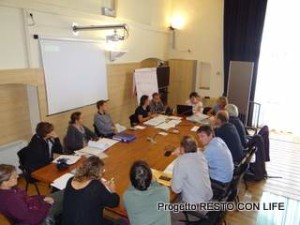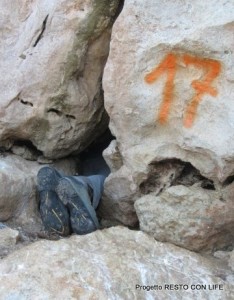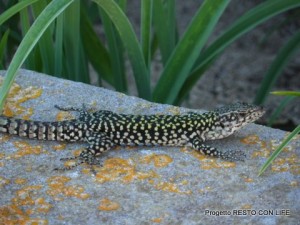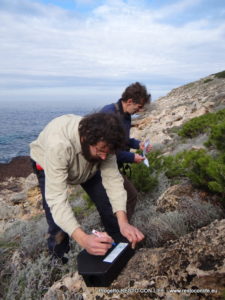
The main operation to eradicate the black rat has finally begun on Pianosa. Hundreds of registered traps, in accessible to species other than the rat and just like the ones used in various towns and cities around the country, have been placed all over the island. Over the course of a few months, Pianosa will literally be reborn, given that, in the absence of one of the worst alien predators in the world, new life will be breathed into the native fauna and flora.
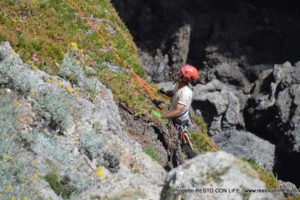
Giannutri will be different next spring: the yellow blooms of the native species will replace the pink colour of the blossom of the Hottentot fig, an exotic and invasive species, removed from the island over the past year. It was a complex operation, with the manual uprooting of the plant from the sheer cliffs overlooking the sea and with the use, in other more accessible zones, of alternative technology intended to deprive the plant of light and cause it to dry up where it grew. In the areas freed from this alien species, the eradication was followed by the planting of native flowers and shrubs that will soon return to cover the island’s coastline.
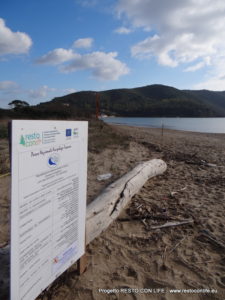
The colours of the flowers on the dunes of Lacona, in the municipality of Capoliveri, will be more striking than ever, now that work has begun on the regeneration of certain areas and to protect the dunes from the strong storm surges. Protective barriers along the edges facilitate the natural recovery of the parts most exposed to the waves. The beach lilies and trumpet flowers are no longer suffocated by the Hottentot fig, a newly eradicated alien plant, and no longer grow in the shadow of the Indian fig, another non-native species.
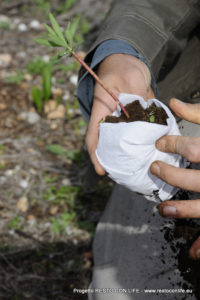
4-8/10/2016 – Researchers from Florence University travelled to Giannutri in support of activities to recover the vegetation in areas in which the Carpobrotus has been removed. Around 150 native plan specimens belonging to the Euphorbia dendroides, Juniperus phoenicea subsp. Turbinata and Pistacia lentiscus species have been planted. The researchers also gathered the seeds of certain native species that will be used to grow new baby plants to be used in future implantations.
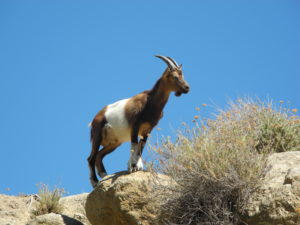
The Montecristo goat census has just been completed. This population count, repeated every year in the same areas by expert operators of the National Park, Forest Ranger Corps and Livorno and Pisa Provincial Police Forces, is useful to identify any changes in observed animal numbers. From a preliminary review, the data appears to be consistent with that of previous years, with the sighting of around 200 goats, an indicator representing the minimum number of goats currently living on the island. However, investigations continue to identify the best method of estimating the goat population density.
This year, once again, the electronic eye of the webcam has followed the Scopoli’s shearwater sitting on their eggs in a cavern on the Island of Pianosa. This new technology allows researchers to direct the cameras using remote controls to record every detail. The chicks will soon hatch and be reared by their parents until they fly the nest in October. In the meantime, preparations are underway on the island for the eradication of the Black Rat, which, unfortunately, as recorded in the past, preys on the newborn chicks. You can watch the shearwaters by clicking on the link below:
“https://www.restoconlife.eu/diretta-streaming-dei-nidi-di-berta-maggiore-allisola-di-pianosa/”
On 8-9 July 2015, technicians from Elbatech completed the installation of the video recording and transmission system at the Scopoli’s shearwater nesting site on Pianosa. Thanks to these webcams, it will be possible to follow live streaming of the first few months of life of the shearwater chicks, up to the moment they take flight.
On 12 and 19 June 2015, researchers from Florence University undertook as survey of the flora and vegetation on the dunes of Lacona, in anticipation of operations to recover and protect the dunes planned by the RESTO CON LIFE Project. Over the course of the two days, 10 transects were put in place, whose monitoring will enable the benefits of the dune recovery operations to be evaluated.
The first campaign of surveys on the Island of Giannutri has been concluded. This involved the mapping of invasive alien plant species and the definition of methods of control and eradication. The species most widespread and dangerous to the conservation of the island’s biodiversity are all the ornamental plants, such as Caprobotus edulis (known as the Hottentot fig), Senecio angulatus and Mesembryanthemum cordifolium.
Pianosa is one of few islands of the Tuscan archipelago that is home to Audouin’s gull nesting sites. This year once again, a colony of around 80 pairs settled, monitored by experts from the Italian Higher Institute for Environmental Protection and Research (ISPRA). The researchers monitored the nests of the Scopoli’s shearwater, carried out a census of the European shag and the herring gull, a species similar to the Audouin’s gull but with more aggressive behaviour. Instead, on land, during the night, they observed and listened to the songs of the nocturnal bird species: European nightjar, scops owl and barn owl.
On 27 May, four classes from Elba middle schools took part with great enthusiasm in the environmental educational activities organised as part of the project.
After an interesting introduction to the dune habitats and the species that inhabit them, the children were challenged with putting into practice all their skills and knowledge on natural biodiversity and conservation.
Filming continues for the project’s promotional video. Operators are using a drone to film the dunes of Lacona and the alien plants that can be a threat to native species typical of this habitat.
May 2015: three adult Audouin’s gulls from the Pianosa colony were fitted with GPS. As in 2014, their positions recorded every half hour provide the Italian Higher Institute for Environmental Protection and Research (ISPRA) with important information on feeding areas and migratory movement. In 2014, one of the birds provided evidence that the Elba site of Ripa Barata, included as part of the Rest con Life Project operations but not in active use for reproduction in recent years, is actually still visited by the species. In 2015, in the immediate vicinity, one of the main feeding areas of birds nesting on Pianosa was identified, at Punta Nera. (Photo: C. Gotti)
11.02.2015 – Field monitoring has begun of the Pianosa hedgehog population. The animals are captured and then released after tagging. The aim is to establish the population density and distribution of the species, as well as the effectiveness of trapping methods. In addition, genetic analysis will be undertaken to determine the characteristics of the population.
Video: F. Giannini Editing: F. De Pietro
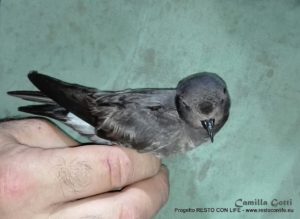
On 18 and 19 June 2014, as part of the final monitoring operations for the ‘Montecristo 2010’ Life Project, sightings of the European storm petrel in the seas surrounding Montecristo were confirmed by Mario Cozzo and Camilla Gotti (Italian Higher Institute for Environmental Protection and Research; ISPRA). Two adults were captured at night on the jetty of Cala Maestra. This event, which coincides with the start of the ‘Resto con Life’ project, appears to be an excellent precondition for operations involving this species envisages precisely for the island of Montecristo.
See ‘Publications’ for a description of what is known about this species in the archipelago.
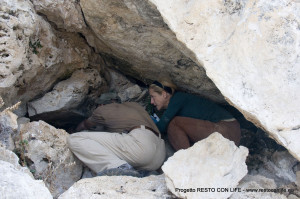 17-21/09/2015 – Monitoring continues of the colonies of Scopoli’s shearwater at Punta del Pulpito and Punta Brigantina; after inspecting 19 nests, researchers found just 3 fledglings close to leaving the nest. In this case, the poor reproduction rate is due to the presence of the black rat on the island, an alien species that preys upon eggs and newborn chicks.
17-21/09/2015 – Monitoring continues of the colonies of Scopoli’s shearwater at Punta del Pulpito and Punta Brigantina; after inspecting 19 nests, researchers found just 3 fledglings close to leaving the nest. In this case, the poor reproduction rate is due to the presence of the black rat on the island, an alien species that preys upon eggs and newborn chicks.
26-27-28/08/2015 The annual census of the Montecristo Goat (Carpa hircus) population has been completed. This operation, undertaken in collaboration with members of the Livorno, Pisa and Siena Provincial Police Forces, began in the afternoon of Wednesday 26 August and ended the morning of Friday 28. The census method used is to record all sightings of the goat by each operator, from vantage points and along established routes, on a dedicated sheet. Once data analysis is complete, the average population density can be estimated.
On 8-9 July 2015, technicians from Elbatech completed the installation of the video recording and transmission system at the Scopoli’s shearwater nesting site on Pianosa. Thanks to these webcams, it will be possible to follow live streaming of the first few months of life of the shearwater chicks, up to the moment they take flight.
On 12 and 19 June 2015, researchers from Florence University undertook as survey of the flora and vegetation on the dunes of Lacona, in anticipation of operations to recover and protect the dunes planned by the RESTO CON LIFE Project. Over the course of the two days, 10 transects were put in place, whose monitoring will enable the benefits of the dune recovery operations to be evaluated.
The first campaign of surveys on the Island of Giannutri has been concluded. This involved the mapping of invasive alien plant species and the definition of methods of control and eradication. The species most widespread and dangerous to the conservation of the island’s biodiversity are all the ornamental plants, such as Caprobotus edulis (known as the Hottentot fig), Senecio angulatus and Mesembryanthemum cordifolium.
Pianosa is one of few islands of the Tuscan archipelago that is home to Audouin’s gull nesting sites. This year once again, a colony of around 80 pairs settled, monitored by experts from the Italian Higher Institute for Environmental Protection and Research (ISPRA). The researchers monitored the nests of the Scopoli’s shearwater, carried out a census of the European shag and the herring gull, a species similar to the Audouin’s gull but with more aggressive behaviour. Instead, on land, during the night, they observed and listened to the songs of the nocturnal bird species: European nightjar, scops owl and barn owl.
On 27 May, four classes from Elba middle schools took part with great enthusiasm in the environmental educational activities organised as part of the project. After an interesting introduction to the dune habitats and the species that inhabit them, the children were challenged with putting into practice all their skills and knowledge on natural biodiversity and conservation.
Filming continues for the project’s promotional video. Operators are using a drone to film the dunes of Lacona and the alien plants that can be a threat to native species typical of this habitat.
On 18 and 19 June 2014, as part of the final monitoring operations for the ‘Montecristo 2010’ Life Project, sightings of the European storm petrel in the seas surrounding Montecristo were confirmed by Mario Cozzo and Camilla Gotti (Italian Higher Institute for Environmental Protection and Research; ISPRA). Two adults were captured at night on the jetty of Cala Maestra. This event, which coincides with the start of the ‘Resto con Life’ project, appears to be an excellent precondition for operations involving this species envisages precisely for the island of Montecristo.
See ‘Publications’ for a description of what is known about this species in the archipelago.
11.02.2015 – Field monitoring has begun of the Pianosa hedgehog population. The animals are captured and then released after tagging. The aim is to establish the population density and distribution of the species, as well as the effectiveness of trapping methods. In addition, genetic analysis will be undertaken to determine the characteristics of the population.
Video: F. Giannini Editing: F. De Pietro
A census of the goat (Capra hircus) population on the island of Montecristo has been completed. This population is the only one to live wild in Italy since ancient times, with morphological features very similar to those of the populations of Crete, the Aegean Islands and Asian populations. Monitoring, carried out using various methods, enables estimates to be made of the minimum population number, the composition of the population and any changes that have taken place. Counting is undertaken from vantage points and along established routes, with several sighting sessions. Preliminary data analysis highlighted the presence of a minimum of 177 animals. Analysis is underway to estimate the average population number.
24.10.2014 – Researchers from Florence University have undertaken a primary survey on the beach of Lacona, in the municipality of Capoliveri.
Technicians carried out natural conservation surveys using aerial photographs and GPS tools; they accurately identified and marked off the protected areas and mapped the invasive alien species found in these areas, amongst which the Indian and Hottentot figs.
The data collected will be used to produce a detailed map of the environment, useful for planning the environmental regeneration operations envisaged as part of the project.
23.10.2104 –A meeting was held on the Island of Elba with the representative of the independent monitoring group, Dr Chiara Caccamo, and the various partners of the Life+RESTO CON LIFE Project: Tuscan Archipelago National Park (PNAT), Italian Higher Institute for Environmental Protection and Research (ISPRA), Florence University and the Forest Rangers Corp, Follonica Regional Office for Biodiversity.
Over the course of the Thursday morning, at the Tuscan Archipelago National Park headquarters, discussions were held with the monitor on the various technical and administrative aspects; whilst in the afternoon, surveys were carried out of the areas involved in the various conservation operations planned as part of the project.
27.09.2014 – A survey was carried out of the Pianosa Scopoli’s shearwater colony at Punta Brigantina to check the nest contents before the young shearwaters flew the nest. Nest monitoring has highlighted the fact that the successful reproduction of shearwater pairs stands at around 20%. The nesting sites in which surviving chicks were found were located in the only cavern treated with rat poison during the reproductive season.
01.07.2014 – The first ex ante wildlife monitoring of the reproductive success of the Scopoli’s shearwater at Punta Brigantina and of the abundance of the Pianosa common wall lizard (Podarcis muralis insulanica) along the transects located in the eastern part of the island has been undertaken.





